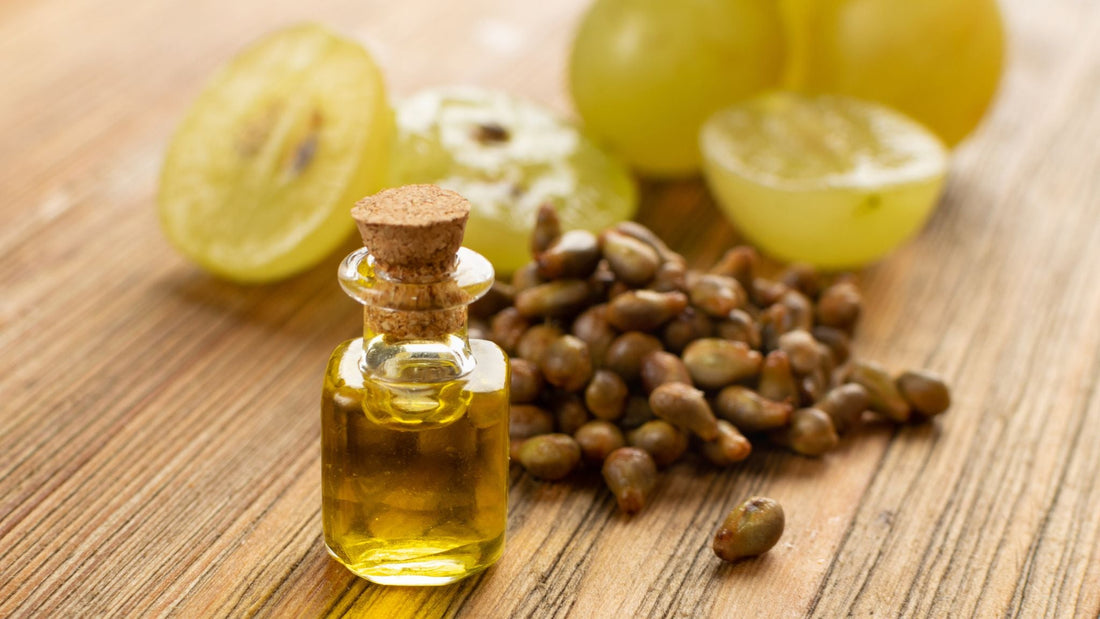Have you ever wondered if the oil you're using is actually pure? You may be shocked to realise that the purity of natural oils is a growing concern.
Many oils are being diluted with cheaper oils, like sunflower oil. We believe that it is essential for you to be aware of the truth behind the oils you are purchasing.
Today, we want to address the purity of grapeseed oil. We hope to equip you with the knowledge needed to make confident and informed decisions when purchasing grapeseed oil.
Read on as we delve into the world of grapeseed oil purity and how to identify authentic products.
Contents
- What Are You Really Buying?
- Understanding Grapeseed Oil
- How Grapeseed Oil Producers Work
- How is Grapeseed Oil Adulterated?
- What Are The Grades of Grapeseed Oil?
- Identifying Pure Grapeseed Oil
- Risks of Adulterated Grapeseed Oil
- Conclusion
What Are You Really Buying?
We collected 6 samples of grapeseed oil from a range of different online retailers and sent them off for third party testing.
All of these samples failed the purity tests.
There was minimal evidence that any of the samples even contained any grapeseed oil.
As shocking as this may be, it is unfortunately very common. So let’s take a deep dive into how this happens, and why.

Understanding Grapeseed Oil
Grapeseed oil is the original upcycled ingredient, from way before upcycling was cool.
The wine industry demands hundreds of thousands of tonnes of grapes. But who wants seeds in their wine? The seeds would otherwise go to waste.
The oil is produced by pressing the seeds of the grapes to extract the natural oil. This is then filtered and refined so the final product is a yellow, neutral scented oil.
It is a very fast absorbing carrier oil, with amazing moisturising properties. It is extremely popular in the cosmetics industry because it's versatile and it can be used for all skin types.
The grapeseed oil market is estimated to be worth well over 500 million dollars per year globally. This market is growing continuously each year, meaning there are hundreds of thousands of tonnes of grapeseed oil sold every year.

How Grapeseed Oil Producers Work
Manufacturers are under pressure to produce large quantities of grapeseed oil. But what happens if they run out of grape seeds?
They’ve got bills to pay, and customers to please. Some will “stretch” their stock by adding sunflower oil to the mix. Others just sell sunflower oil and pretend it’s grapeseed.
The scary part is, they are prepared to label all of these as just 'Grapeseed Oil'.
So when the oil is brought into the country, the only the person who bought it knows how much grapeseed oil is really in there. When it is sold on to a wholesaler, there’s no trace of this deception left.
How is Grapeseed Oil Adulterated?
In technical terms, natural oils are mostly made up of Triglycerides, which are molecules containing fatty acids.
There are many types of fatty acids, with names like Oleic Acid, Linoleic Acid etc. A fatty acid profile tells you what percentage of each fatty acid is in the oil.
Here’s an example of the range you would expect to see grapeseed oil fatty acids in:

Understanding Sunflower Oil
Sunflower oil is one of the cheapest oils on the market, making it an easy option for adulterators.
There are a few types of sunflower oil: High Linoleic, Mid-Oleic, High Oleic, High Stearic/High Oleic.
The one that is relevant to us, for grapeseed oil adulteration, is High Linoleic sunflower oil
Let’s look at the fatty acid profile of high linoleic sunflower oil next to 100% pure grapeseed oil:

They look very similar and you can understand why many people wouldn't notice any issues.
From our tests, we found most of the ‘grapeseed oil’ on the market looks just like this sunflower oil fatty acid profile.
So the bottle says grapeseed oil, the certificate of analysis says grapeseed oil, but it’s actually just sunflower oil.
This deception could mean you are using an oil that may cause skin irritations, allergic reactions and sensitivity.
When purchasing grapeseed oil for its specific health benefits, this potential adulteration means you may not be getting the desired effects.
By being aware of this and taking steps to ensure the purity of the product, it helps you to make informed decisions and avoid potential health risks.

What Are the Grades of Grapeseed Oil?
Cosmetic Grade
Most cosmetic grade grapeseed oils are just sunflower oil or 90% sunflower oil and 10% grapeseed oil. Apparently it’s OK to sell it as “grapeseed oil” if you mention that it’s cosmetic grade.
BP Grade
Unfortunately, british pharmacopoeia grade is not as trustworthy as it might sound. It is likely the ‘grapeseed oil’ is actually 100% sunflower oil.
Many fatty acid profiles for BP grade grapeseed oils have no max limit for behenic acid. This easily allows for most sunflower oils to pass as grapeseed oil.
Ph. Eur Grade (we call it Pharma grade)
To meet the European Pharmacopoeia specifications, it has to be 100% pure grapeseed oil.
This is the grade you want to be looking for!

Identifying Pure Grapeseed Oil
Unfortunately, identifying 100% pure grapeseed oil isn’t that easy.
Visually, refined grapeseed oil (on the left) typically exhibits a golden colour and sometimes has a green hue. Whereas, sunflower oil (on the right) presents a lighter yellow shade.
When blended, the oil looks a bit lighter to pure grapeseed oil, however this may not always be obvious when analysing the oil.
When providing technical documents, some suppliers will send documents that say the oil is pharma grade, but this may not be true.
The only way to be certain the oil is pure and that suppliers are being honest, is by doing third party lab testing.
So why doesn’t everyone do it? It’s expensive, time consuming and you have to be an expert to understand what exactly you’re testing for.
Here’s a checklist:

Risks of Adulterated Grapeseed Oil
One of the main concerns when using adulterated grapeseed oil is the potential for allergic reactions or skin irritations. It could lead to skin rashes, itching, redness in individuals with sensitivities or allergies.
Not only is it unsafe for your skin, but adulterated grapeseed oil may not provide the same health benefits as pure grapeseed oil.
If there is a lack of transparency in the supply chain, it raises concerns about the knowledge and awareness of retailers.
If retailers are unknowingly selling adulterated grapeseed oil, they may not be able to provide accurate information or guidance to consumers.

Conclusion
Grapeseed oil is a fast-absorbing, versatile oil that has amazing moisturising properties. Why wouldn't you want this in your cosmetic creations?

It is important to take steps to ensure you are purchasing pure and authentic grapeseed oil. Research suppliers of grapeseed oil to ensure the purity of the oil they use so you can enjoy the benefits of 100% pure grapeseed oil!
Our promise: We guarantee that our grapeseed oil is 100% pure. Andy has personally visited the production facility to ensure its authenticity. We also conduct third-party lab tests to confirm its purity.
Continue Reading
Now you have read all about the purity of grapeseed oil, why not continue reading?
- Want to make some summer soap? Check out our grapefruit soap recipe!
- Learn about the potential benefits of lavender with our lavender oil benefits blog
-
Interested in making a natural tinted lip balm? Try this simple tinted lip balm recipe!
Let us know your thoughts on the purity of grapeseed oil in the comments!



